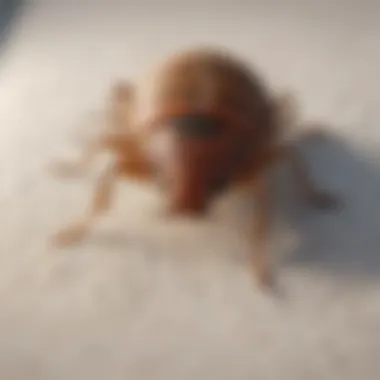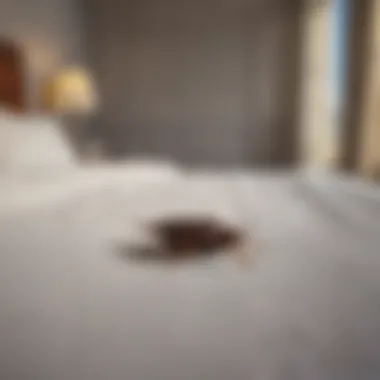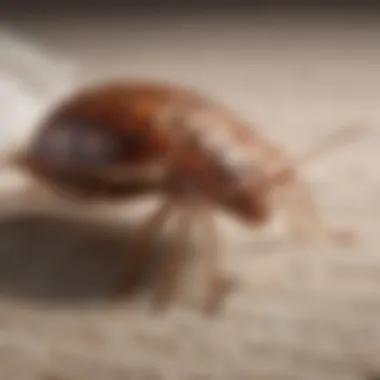Effective Bed Bug Extermination Strategies in Boise


Intro
Bed bugs are insidious pests that can impact homes in Boise. Understanding their behaviors and identifying them is crucial for effective extermination. This article will delve into the strategies for eradicating these pests, and underscore the value of professional help. By learning about the pests’ habits and the intervention methods, homeowners can make informed choices that protect their living spaces.
Understanding Pests
Definition of Pests
Pests, particularly bed bugs, are small insects that thrive in human habitats. These creatures hide in bedding, furniture, and cracks in walls. They do not transmit diseases, yet their presence can cause sleepless nights, anxiety, and skin irritations. Knowledge about pests' life cycle is necessary for managing an infestation effectively.
Importance of Pest Identification
Identifying bed bugs early is vital. Homeowners must recognize signs such as small reddish-brown stains on sheets, dark spots of bed bug excrement, and the bugs themselves. Effective pest control starts with understanding what you are dealing with. The more accurate the identification, the better the solution that can be applied.
Prevention Techniques
Home and Garden Preventative Measures
Preventing bed bugs is often more effective than treating an infestation. Here are some strategies homeowners can implement:
- Regular Vacuuming: Maintain cleanliness in living areas and especially near beds.
- Seal Cracks and Crevices: Bed bugs love to hide in walls; sealing these helps reduce their habitats.
- Monitor Used Furniture: Be cautious when bringing used items into your home and check for signs of bed bugs.
Seasonal Prevention Tips
During certain times of the year, pest activity may increase. Here are practical tips to keep your home pest-free:
- Inspection During Travel Seasons: When returning from vacation, inspect luggage and belongings for bed bugs.
- Winter Preparations: Seal windows and insulate doors to prevent any pests from entering as they search for warm places.
Eco-Friendly Pest Control Solutions
Overview of Sustainable Practices
For those who are environmentally conscious, eco-friendly pest control solutions are available. These practices aim to mitigate infestations while causing minimal harm to the environment. Utilizing non-toxic methods can protect not just the home, but also the ecosystem.
Natural Remedies and Their Effectiveness
Several natural remedies have shown promise in repelling or exterminating bed bugs. Methods like essential oils, diatomaceous earth, and heat treatments can be effective. While these solutions may not provide the same immediate results as chemical treatments, they are safer options for families and pets.
Understanding bed bug extermination is essential for ensuring a pest-free home. Through effective identification, prevention techniques, and sustainable practices, homeowners in Boise can combat this pervasive issue.
Prolusion to Bed Bugs
Understanding bed bugs is crucial for effective pest management. This section aims to provide foundational knowledge that highlights key aspects of bed bugs, including their characteristics and life cycle. Knowing these details will equip homeowners in Boise to better recognize, address, and prevent infestations.
Definition and Characteristics
Bed bugs, scientifically known as Cimex lectularius, are small, reddish-brown insects that feed on the blood of humans and animals. They are typically about the size of an apple seed, around 5 to 7 millimeters long. Bed bugs do not have wings, which limits their mobility yet encourages their preference for nesting near sleeping areas. Their flat bodies allow them to hide easily in crevices, cracks, and folds of furniture or bedding.
One of the key characteristics of bed bugs is their resilience. They can survive several months without feeding, which complicates eradication efforts. Moreover, bed bugs are known for their nocturnal feeding habits. They tend to emerge during the night when their hosts are asleep to consume blood without raising alarm.
Importantly, bed bugs do not transmit diseases. However, their bites can cause significant discomfort, allergic reactions, and anxiety in affected individuals. Recognizing their characteristics helps homeowners to identify potential bed bug infestations early.
Life Cycle of Bed Bugs
Understanding the life cycle of bed bugs is vital for effective extermination strategies. Bed bugs undergo a series of life stages: egg, nymph, and adult. A female bed bug can lay up to five eggs per day, with a total of 200 to 500 eggs in her lifetime. The eggs are small, about 1 millimeter in size, and are often laid in hidden places near their feeding sources.
The eggs hatch in about one to two weeks, and the emerging nymphs are smaller and lighter in color compared to adults. Nymphs go through five molts over a period of about five weeks. Each molt requires a blood meal to advance to the next stage. By the time they reach adulthood, they have developed the ability to reproduce, further perpetuating the infestation cycle.
The entire cycle from egg to adult can take as little as five weeks under optimal conditions. This rapid reproduction underscores the importance of timely and effective intervention.


Understanding the life cycle of bed bugs is crucial for implementing timely and effective extermination measures.
The Bed Bug Problem in Boise
Bed bugs have emerged as a significant challenge for many residents in Boise. Understanding this problem is crucial for homeowners and renters alike. Bed bugs are more than just an inconvenience; their presence can lead to stress and a decrease in quality of life. This section will delve into current trends related to infestations, as well as the dynamics particular to urban settings like Boise.
Current Trends in Infestations
In recent years, Boise has witnessed a marked increase in bed bug infestations. Various reports indicate a rise in cases reported to pest control companies. This trend reflects both local and national patterns, as bed bugs have resurged in many urban areas. The reasons behind this surge are multifaceted. For instance, more travel, especially post-pandemic, allows these pests to spread more easily. As people visit hotels, motels, or even friends, they unknowingly carry bed bugs back home.
Monitoring local resources can also aid in understanding the scope of the problem. Community forums, pest control services, and social media often highlight outbreaks in specific areas.
Factors Contributing to Bed Bugs in Urban Areas
Urban areas, including Boise, present unique challenges for bed bug management. The density of living arrangements, such as apartments and condos, facilitates easier movement of these pests between units. When one apartment suffers an infestation, adjacent units can soon follow. This interconnectedness complicates effective eradication efforts.
Key factors that contribute to increased bed bug populations in urban settings include:
- High Population Density: With many residents close together, it’s easier for bed bugs to travel and establish new colonies.
- Frequent Movement: Many people relocate often, whether for work or personal reasons. Moving furniture and belongings can inadvertently introduce bed bugs to new locations.
- Shared Spaces: Public places like laundromats, libraries, and offices are hotspots for bed bug transfer, as they can hitch a ride on clothing or bags.
- Lack of Awareness: Many individuals do not recognize the signs of an infestation until it becomes severe. This can delay timely treatment and increase the spread.
"A proactive approach is vital to manage bed bugs effectively. The sooner the signs of infestation are detected, the easier it will be to address the problem."
In summary, understanding the bed bug problem in Boise involves recognizing current trends and the specific urban factors that contribute to infestations. Being informed equips homeowners and residents with knowledge that facilitates early detection and effective management.
Identifying Bed Bug Infestations
Identifying bed bug infestations is the first step in managing this troubling pest. Understanding how to detect these insects can save residents of Boise not only stress but also money. Early identification helps in taking swift action before the infestation grows.
Signs of Bed Bugs
Recognizing the signs of bed bugs is essential for effective pest management. Firstly, the most common indication is bites on the skin. These usually appear in clusters and can be itchy, red welts.
Next, one might find small dark spots on bedding, which are actually bed bug excrement. Additionally, shed skins from young bugs may be seen, as they go through several molts.
Here are more signs to watch out for:
- Blood stains on sheets or mattress
- An unpleasant, musty odor from infested areas
- Live bugs or the aforementioned shed skins can sometimes be spotted in daylight, often in or around sleeping areas.
Being vigilant and aware of these signs can help address the issue promptly.
Common Hiding Spots
Bed bugs are skilled at hiding in various places. Their small size allows them to fit in tight spaces. Knowing where they are likely to hide can aid in effective inspections and treatments.
Typically, the following locations should be scrutinized:
- Mattresses and box springs: These are prime targets due to the close proximity to sleeping humans.
- Bed frames and headboards: They often reside in seams and cracks.
- Furniture: Chairs, couches, and nightstands can also harbor bed bugs, especially if they are old or not frequently cleaned.
- Baseboards: Cracks and crevices in baseboards are ideal for undetected infestations.
- Luggage and personal items: After travel, bed bugs can hitch a ride back home.
It is imperative to perform thorough inspections in these areas regularly. If signs of bed bugs are spotted, the need for professional help becomes clear.
"Early detection is critical in bed bug management. The sooner you identify the problem, the easier it is to resolve."
By focusing on identification, Boise residents can manage infestations efficiently and effectively.
For more information on bed bugs, consider checking out Wikipedia or Britannica.
The Importance of Professional Extermination
When dealing with bed bugs, the importance of professional extermination cannot be overstated. These pests are notoriously difficult to eliminate, and attempting to manage an infestation without the right expertise can lead to ineffective outcomes. Professional exterminators possess specialized training and knowledge, which allows them to identify and treat infestations more effectively than the average homeowner.


One of the key factors to consider is that bed bugs have developed considerable resistance to many over-the-counter pesticides. DIY treatments may provide temporary relief but are often not strong enough to eradicate the entire population. Professional exterminators have access to more potent solutions and the latest technology that is effective against these resilient insects.
Furthermore, extermination methods typically involve more than just spraying chemicals. A comprehensive approach is necessary to address the hidden populations of bed bugs and their eggs, which can remain undetected for long periods. Instead of merely focusing on visible signs, trained professionals can conduct thorough inspections, utilizing tools like heat treatments or vacuum systems that can reach areas typically missed by homeowners. This holistic view significantly increases the chances of a permanent solution.
Always rely on trained pest control professionals for effective bed bug treatment.
Maintaining a pest-free environment is crucial for both health and well-being. In addition to causing discomfort through bites, bed bugs can negatively impact mental health due to the stress of living with an infestation. Relying on professional extermination not only aids in immediate relief but also restores peace of mind.
Benefits of Hiring a Bed Bug Exterminator
Hiring a bed bug exterminator comes with multiple advantages. Here are some of them:
- Expertise and Experience: Exterminators have considerable knowledge about bed bug behavior and treatment methods. This expertise allows them to devise a strategy tailored to each infestation.
- Effective Solutions: Professionals use effective treatments that are not generally available to the public, including a combination of chemical and non-chemical methods.
- Safety Concerns: Bed bug extermination can involve potentially hazardous chemicals. Licensed professionals understand proper handling and application to ensure safety for the household, pets, and the environment.
- Comprehensive Treatment Plans: A professional approach often includes follow-up visits to ensure complete eradication, as well as guidance on how to prevent future infestations.
- Time-Saving: The process of eliminating bed bugs can be lengthy, and professionals can expedite this process, allowing homeowners to return to normal life quicker.
Choosing a Qualified Exterminator in Boise
Selecting a qualified bed bug exterminator in Boise requires careful consideration. It is essential to look for several criteria when making a choice:
- Licensing and Certifications: Ensure the exterminator operates under a valid license and has certifications relevant to pest control.
- Reputation and Reviews: Research online reviews and ask for testimonials from previous clients. A good reputation reflects reliability and effectiveness.
- Experience in Local Pests: Choose someone who has experience specifically dealing with bed bugs, as they will be aware of methods that work best in the Boise area.
- Transparent Pricing: A reputable exterminator should provide a clear estimate of costs before beginning the work, including potential follow-up visits.
- Aftercare Services: It’s vital to inquire about any follow-up services or maintenance plans they offer to prevent future infestations.
By selecting a competent exterminator who meets these criteria, homeowners can significantly increase their chances of effectively eliminating bed bugs and maintaining a pest-free environment.
Extermination Methods
The methods employed for exterminating bed bugs are critical for ensuring complete elimination. Understanding these methods not only informs homeowners about their options but also allows them to make educated choices regarding pest control services. Each method has its strengths and weaknesses, and knowing these can help prevent future infestations. It is essential to consider factors such as safety, effectiveness, cost, and environmental impact when evaluating extermination strategies.
Chemical Extermination Techniques
Chemical extermination techniques involve the use of insecticides designed to kill bed bugs at various life stages. Several formulations exist, including sprays, powders, and foggers. These chemicals work by disrupting the nervous system of the pests, ultimately leading to their demise.
Benefits of Chemical Techniques:
- Quick Action: Many insecticides can eliminate bed bugs almost immediately, providing quick relief.
- Access to Hard-to-Reach Areas: Chemicals can be applied in tiny crevices where bed bugs often hide.
- Supplementary Treatments: These techniques can be part of a broader pest management plan.
However, it's crucial to consider a few considerations:
- Safety Concerns: Chemical sprays may pose health risks, particularly to children and pets. Protective measures are necessary during application.
- Resistance Issues: Some bed bug populations have developed resistance to common insecticides, making them less effective. Regular monitoring is imperative.
Heat Treatment for Bed Bugs
Heat treatment involves raising the temperature of an infested area to a level that is lethal to bed bugs, usually around 118°F (48°C) for at least 90 minutes. This method can be highly effective, particularly in destroying all life stages of bed bugs.
Benefits of Heat Treatment:
- Comprehensive Elimination: It can reach areas that chemicals might miss, including inside mattresses and furniture.
- No Chemical Residue: This method avoids the health risks associated with chemical treatments, making it a safer choice.
- Quick Process: Heat treatments can often be completed in a short time frame, allowing for quicker return to normal activities.
The limitations include the need for specialized equipment and trained professionals to effectively execute the process. Improper usage can lead to risks such as fire or damage to belongings.
Integrated Pest Management Approaches
Integrated pest management (IPM) combines multiple strategies to manage bed bug populations effectively. This approach considers prevention, monitoring, and control, using the least harmful options whenever possible.
Components of IPM:
- Inspection and Monitoring: Regular inspections to pinpoint potential problems early.
- Physical Controls: Methods like vacuuming and sealing cracks where bugs may enter help reduce populations.
- Education and Awareness: Providing resources for homeowners about bed bug prevention ensures the problem does not escalate in the future.
Advantages of IPM:
- Sustainable Practices: Focusing on long-term solutions reduces reliance on chemicals, helping to preserve the environment.
- Cost-Effectiveness: By preventing infestations, homeowners can save on potential extermination costs.


Employing an integrated approach leads to a more balanced, effective response to pest management.
The choice of extermination method significantly affects the outcome of bed bug management, emphasizing the need for well-informed decisions.
In summary, understanding the various extermination methods allows homeowners in Boise to navigate their options intelligently, ensuring not only effective eradication of bed bugs but also long-lasting results.
After the Extermination Process
Understanding the phase following bed bug extermination is crucial for long-term success in managing and preventing future infestations. This section outlines key strategies to maintain a pest-free environment and avoid re-infestation. Failing to implement these practices can lead to a recurrence of bed bugs, negating the efforts and finances spent on extermination.
Preventing Future Infestations
One of the most effective ways to prevent future infestations is to maintain vigilance in your living space. Regular cleaning can help to eliminate any potential hiding spots for bed bugs. Here are some specific practices that can be adopted:
- Vacuum regularly: Focus on areas like carpets, rugs, and upholstered furniture where bed bugs may hide.
- Wash bedding frequently: Hot water can kill bed bugs and their eggs. Make it a habit to wash sheets and pillowcases weekly.
- Use protective covers: Encasements for mattresses and box springs can prevent bed bugs from entering these areas.
- Declutter your home: Reducing clutter makes it easier to spot bed bugs and reduces hiding places.
- Be cautious when traveling: Always inspect hotel rooms and wash clothes after returning.
By incorporating these habits into daily life, homeowners can significantly decrease the risk of a new infestation.
Monitoring and Maintenance Strategies
Adopting effective monitoring and maintenance strategies is essential post-extermination to ensure that any potential issues are addressed immediately. Regular inspections can identify bed bugs before they become a serious problem. Consider the following methods:
- Set up monitoring devices: Utilizing bed bug interceptors can help trap any insects that might be present. These devices are placed under the legs of beds and furniture to catch bed bugs as they move.
- Schedule follow-up inspections: Hire your exterminator for periodic checks to assess the situation and ensure that the treatment was effective.
- Educate your household: Make sure everyone in your home recognizes the signs of bed bugs so they can report any sightings quickly.
- Keep records: Document any signs of bed bugs, along with actions taken and observed outcomes. This can assist exterminators if problems arise again.
"Preventive maintenance after extermination is as critical as the extermination itself."
All these strategies promote an ongoing assessment of your home's status concerning pests. The proactive measures required post-extermination establish a formidable line of defense against re-infestation.
Local Resources and Support
Local resources and support systems are critical in combating bed bug infestations in Boise. The nature of these pests requires not only effective extermination but also community engagement and ongoing education. Resources available in the area help reinforce the strategies employed by individuals and professionals alike. Understanding these resources arms residents with knowledge and options that may not be readily apparent.
Pest Control Services in Boise
Boise hosts a range of pest control services specializing in bed bug extermination. These companies are equipped with the latest technology and extermination methods. Most important among them are trained professionals familiar with local pest behavior. Some reputable companies include Terminix, Orkin, and Boise Pest Control. Each offers tailored services designed to assess the intensity of the infestation, explore treatment options, and provide follow-up support.
Important attributes to consider when selecting a pest control service:
- Experience: Look for companies with a proven track record in handling bed bugs specifically.
- Certifications: Certification from relevant state authorities is crucial. It ensures that technicians use approved methods.
- Customer Reviews: Check ratings and reviews from local customers to evaluate service quality. Websites like Yelp or local Facebook groups can provide insight.
Effective pest control services will not only exterminate existing infestations but also educate homeowners on prevention tactics. This dual approach strengthens the overall management of bed bugs in the community.
Community Initiatives for Pest Awareness
Community-driven initiatives play a significant role in pest awareness related to bed bugs in Boise. Local organizations often run programs aimed at educating the public about identification, prevention, and treatment options. For example, the Boise Public Health Department frequently organizes workshops and informational campaigns. This outreach equips homeowners with necessary knowledge.
Some specific community initiatives include:
- Workshops: Regular workshops teaching residents about bed bug identification and effective prevention strategies.
- Information Posters: Banners and flyers placed in high traffic areas provide quick tips on recognizing signs of bed bug infestations.
- Social Media Campaigns: Platforms like Facebook and Reddit host discussions and advice threads that foster community support.
"Education is the first line of defense against bed bugs."
Furthermore, community partnerships with local pest control companies may result in discounted services for residents participating in educational events. The cooperation between civic organizations and pest experts amplifies outreach efforts.
Engaging with these local resources not only aids individual households but collectively strengthens Boise's battle against bed bugs.
Closure
Understanding the full spectrum of bed bug extermination methods is essential for effective pest management. With the critical insights presented in this article, homeowners and individuals can grasp the urgency of addressing bed bug infestations properly. Engaging professionals who comprehend local conditions ensures tailored solutions that are essential in a place like Boise. The key takeaways from this discussion will aid in making informed decisions and secure a healthier environment.
Summary of Key Points
- Identification: Knowing the signs of bed bugs and where they hide is vital for quick action.
- Professional Extermination: Hiring certified exterminators increases the chances of effectively removing these pests.
- Extermination Methods: Understanding chemical treatments, heat methods, and integrated pest management helps homeowners choose the right approach.
- Post-Extermination Care: Prevention is key. It’s critical to apply necessary maintenance strategies to avoid future infestations.
- Local Resources: Leveraging pest control services and community initiatives can provide additional support and awareness.
Final Thoughts on Bed Bug Management
Dealing with bed bugs involves not just extermination but also a commitment to prevention. Homeowners must remain vigilant after eradication efforts. Regular monitoring and an understanding of the environment can significantly reduce the likelihood of reinfestation. Key takeaway is that empowering oneself through knowledge and professional support leads to a sustainable pest management plan. Persistent education on this matter facilitates a proactive approach against bed bugs, a menace that can otherwise disrupt daily life.



